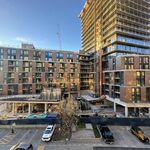The standard for stop spacing used by the TTC is 300 to 400 metres. Stops are only being removed where the resultant spacing is within this guideline. These are ridiculously close stops, often as little as a hundred metres apart. I could see that stops every kilometre would tend to attract more riders than every two kilometres (the coverage area actually doubles), but you get diminishing returns as the stops get closer and closer together.
The difference in coverage area between 150 metre stops and 300 metre stops is pretty minimal, but the difference travel in time is significant. It is true that dwell time increases per stop with reduced stops, assuming that the limitation is the capacity of a door. But we have 30-metre streetcars with all-door loading, so at minor stops such as the ones being removed, the dwell time is pretty much fixed.
Furthermore, the time spent accelerating, decelerating, opening and closing doors is lost per stop, not per passenger. This amounts to around 15 seconds per stop. That might not sound like much, but consider that on a line with a 2 minute headway, cutting the travel time by 1 minute in each direction (i.e. 2 min round trip) reduces the fleet requirement by 1 vehicle. That's $3Million in capital cost saved, plus all the operator, maintenance and energy costs.
Then there's the issue of schedule variability. Streetcars that are early will tend to stop at very few stops, while streetcars that have abnormally long headways will tend to stop at every single stop. With fewer stops, the difference between these two conditions is less, so late vehicles are less likely to get irreparably bogged down.




